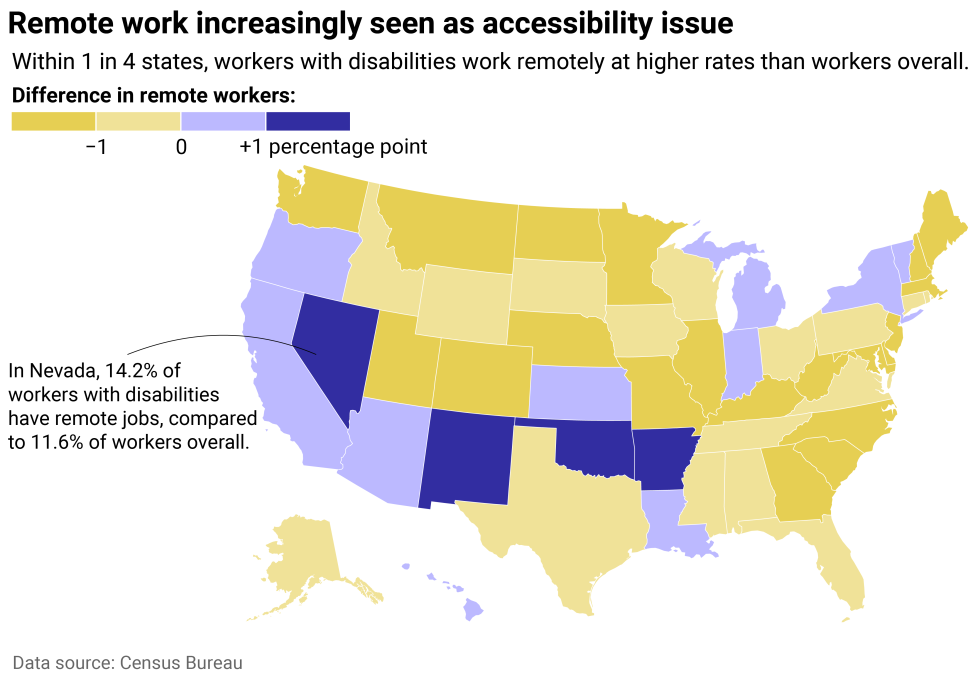
Americans with disabilities work remotely more than the general population in some states. Here's how Louisiana compares.
This story originally appeared on accessiBe and was produced and distributed in partnership with Stacker Studio.
Americans with disabilities work remotely more than the general population in some states. Here's how Louisiana compares.
The national adoption of remote work spurred by the pandemic has been touted for opening accessibility opportunities to the larger labor force. And yet, workers with disabilities still have varied access to remote work throughout the country.
Nationally, 13.1% of workers with disabilities were remote, compared to 13.9% of American workers overall. While these figures may seem on par, there is great variation when comparing geographic locations. In several states, workers with disabilities outpace the general population in remote work, for example.
Using Census Bureau data, accessiBe identified where Americans with disabilities are working remote jobs at higher rates than workers overall, and revealed where disparities remain for people with disabilities.
In Louisiana, 8.9% of individuals with disabilities worked from home in 2023, compared to 8.1% of all workers.
While it's important to note that regardless of location, a person with a disability can face digital accessibility barriers, the rise of remote work has made traditional office jobs more accessible to employees with disabilities in many ways. As remote work has become a cultural norm in many industries, workers with disabilities are less burdened to make case-by-case on-site accommodation requests to employers. Remote jobs remove other potential barriers some may face, such as commutes that may be taxing or challenging for people with mobility differences and workplaces with inaccessible walkways, desks, and parking lots.
Meanwhile, they allow individuals to use the assistive technologies and equipment already incorporated in their homes or to take necessary breaks with greater ease. Under the Rehabilitation Act, federal agencies are mandated to ensure that their electronic and information technology can be accessed by everyone, including people with disabilities. In the private sector, many accessibility resources and services can help employers with a remote workforce ensure company intranet, website portals, video conferencing, communication policies, and productivity tools meet digital accessibility guidelines so all employees have necessary working tools no matter where they may be located.
In 2023, a record 22.5% of Americans with disabilities were employed, according to the Bureau of Labor Statistics. That was up 1.2 percentage points from 2022—three times the increase measured among Americans with no disability.
Factors such as labor shortages and an aging workforce may have contributed to this trend. Still, the share of workers with disabilities in typically higher-paying management, business, science, and arts occupations increased by 4 percentage points to 34.8% between 2019 and 2023, outpacing growth that workers without disabilities saw in these roles and decreasing their disparity.

Individuals with disabilities have higher remote work access in a quarter of states
The remote work wave has not reached workers with disabilities equally across the nation.
In most states, a smaller share of workers with disabilities have remote jobs compared to the rate for workers overall. In Colorado, North Carolina, and the District of Columbia, remote work rates for all workers and those with disabilities surpass national averages—quite substantially in the latter two. Workers with disabilities also have higher workforce participation rates in Colorado and Washington D.C., potentially meaning more workers in nonremote-capable roles.
However, in 13 states, workers with disabilities have remote jobs at higher rates than workers overall. The difference is striking in a few of these states. In Nevada, workers with disabilities lead the overall working population in remote jobs by 2.6 percentage points. Workers who report having disabilities in New Mexico, Oklahoma, and Arkansas also work remotely at notably higher rates.
Interestingly, these states' overall work-from-home rates are lower than the national average. In these cases, remote access at work may be limited and potentially reserved for those with accessibility needs. For instance, in Nevada, the state government issued new guidance in December 2023 specifying that for agency employees, "remote work is the exception, not the rule." The rule provided that remote work agreements would be approved individually and not applied across entire departments, divisions, or other broad categories—limiting remote opportunities for workers.
While this particular guidance only applies to state government workers, it reflects a broader work culture that is less remote-friendly. Allowing individuals with disabilities to work at home is one type of reasonable accommodation, required by the Americans with Disabilities Act for employers with 15 or more employees. In turn, remote work remains a viable option for employees with disabilities as an exception to otherwise tight restrictions on remote work.
Importantly, not all workers with disabilities want remote jobs or to work in roles suitable beyond the physical workplace. Working remotely can cause isolation and loneliness. For people with disabilities, who already face disproportionate stigma and exclusion in social settings, these effects can be particularly damaging.
Still, remote work offers myriad benefits for workers with and without disabilities alike. It can potentially promote equity and inclusion—especially when executed with the proper tools, practices, and normalization, rather than treated as a one-off accommodation.
Read the national analysis to see how other states compare.
This story features data reporting and writing by Paxtyn Merten and is part of a series utilizing data automation across 50 states and Washington D.C.



